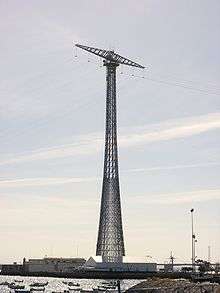Pylons of Cádiz

The Pylons of Cádiz, also known as the Towers of Cádiz, are two tall pylons supporting a double-circuit 132 kV three-phase AC powerline[1] over the bay of Cádiz, Spain starting at Puerto Real Substation[Location 1] to the substation of the former Cadiz Thermal Power Station situated on the peninsula upon which the city of Cádiz stands.[Location 2]
Description

The crossing consists of 16 pylons: two suspension pylons, both 158 metres tall, that carry the line over the Bay of Cádiz,[1] two strainer portals built of concrete and at each strainer portal a group of 6 monopolar strainers, which are used to carry the conductors from the strainer portal to the first standard line tower (at the northern end of the span) respectively to the switchyard of Cadiz Substation (at the southern end of the span).
The strainer portal at the southern end is situated close to Cadiz Substation,[Location 3] that of the northern end at Matagorda.[Location 4] Both strainer portals are including their upper mentioned monopolar strainers fenced-in.
The huge suspension towers are situated in Cádiz near Fort Puntales and the Puntales Naval Station[Location 5] and at Matagorda quarter near the commercial wharves.[Location 6]
The rest of the line consists of pylons with 3 crossbars carrying 6 conductors. An interesting feature is, that the powerline crossing does not use a ground conductor in the span section despite its great height.
Design and construction
The huge suspension towers, which are of very unconventional design, were conceived and designed by the Italian engineer, Alberto Toscano.[1]
Each is a hollow mast resembling a truncated cone (or frustum). The diameter of the frustum decreases from 20.7 metres at the base to six metres at the top.[1] The towers, which rest on reinforced concrete plinths carry on their pinnacle a single crossbar with rhomboid profile, on which the insulators carrying the conductors are fixed. A helical staircase winds its way up the interior of the structure to the top.[1]
This unconventional mode of construction was chosen because Spanish steel mills were unable to produce massive steel carriers at the time, and importing such carriers was impossible because of the Francisco Franco regime.
The construction was carried out under the supervision and direction of Remo Scalla, a close friend of Alberto Toscana. The same team of Toscana, the designer, and Scalla, the builder, also joined forces in building the structures supporting the lines that span the Strait of Messina, between Calabria, on the mainland of Italy, and the island of Sicily. The Cádiz project started during the latter part of 1957 and concluded in 1960. Upon completion, the towers were acquired by the Spanish National Institute of Industry.
Gallery
 Towers of Cádiz, 1958
Towers of Cádiz, 1958 Towers of Cádiz, 1959
Towers of Cádiz, 1959 Towers of Cádiz, 1960
Towers of Cádiz, 1960 Towers of Cádiz, 1960, Fort Puntales
Towers of Cádiz, 1960, Fort Puntales Tower elevator
Tower elevator- Puntales tower site, from the city of Cádiz
See also
- Costa de la Luz
- List of towers
- Hyperboloid pylons of similar design by V. G. Shukhov can be seen on the Oka River near Nizhniy Novgorod, Russia.
Locations
- ↑ 36°31′05″N 6°9′20″W / 36.51806°N 6.15556°W
- ↑ 36°30′17″N 6°15′56″W / 36.50472°N 6.26556°W
- ↑ 36°30′20.29″N 6°15′56.13″W / 36.5056361°N 6.2655917°W
- ↑ 36°31′16.85″N 6°14′45.35″W / 36.5213472°N 6.2459306°W
- ↑ 36°30′29.86″N 6°15′44.15″W / 36.5082944°N 6.2622639°W
- ↑ 36°31′7.61″N 6°14′56.92″W / 36.5187806°N 6.2491444°W
References
- 1 2 3 4 5 "Colossal Towers in Spain Have Become Landmarks". 2013-10-02. Archived from the original on 2013-10-02. Retrieved 2016-08-26.
External links
| Wikimedia Commons has media related to Pylons of Cádiz. |
Coordinates: 36°31′09″N 6°14′55″W / 36.51917°N 6.24861°W
- High Voltage Masts to Cadiz Island at Structurae
- http://www.skyscraperpage.com/diagrams/?b45670
- http://www.skyscraperpage.com/diagrams/?b45671
- Google Maps: Matagorda Pylon (Pylon on Mainland)
- Google Maps: Puntales Pylon (Pylon at Cadiz)
- Panoramio: picture.
- A set on Flickr.
- Picture of the strainer